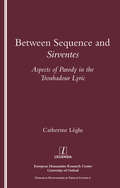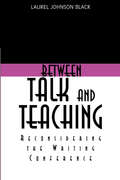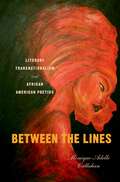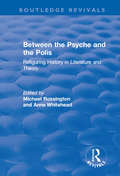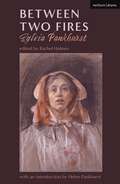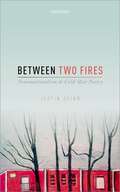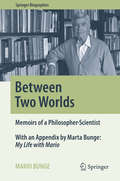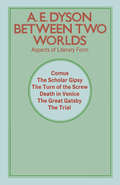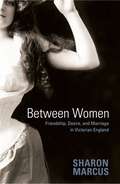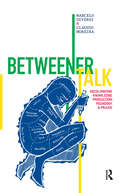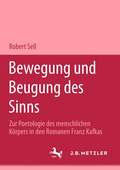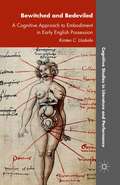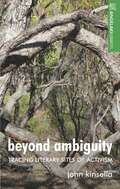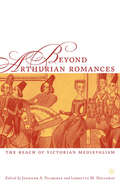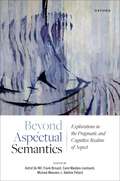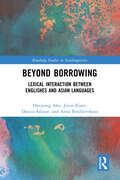- Table View
- List View
Between Sequence and Sirventes: Aspects of the Parody in the Troubadour Lyric
by Catherine Leglu"Parody marks the troubadour lyric from the outset, informing composition, performance and reception. This ground breaking study moves away from courtliness, the focus of most previous studies, and places troubadour parodic preactice int he context of the social and spiritual debates of 12th and 13th century Occitania. Leglu analyses the complex relationship between troubadour verse and the Aquitanian para-liturgical Latin corpus. She charts the development of a chain of texts linked by a common formal mode derived from this Latin sequence and traces patterns of rewriting, ranging from scurrilous attacks, through playful competition, to recuperation of the sacred content in serious parody."
Between Talk And Teaching: Reconsidering the Writing Conference
by Laurel BlackThe teacher-student conference is standard in the repertoire of teachers at all levels. Because it's a one-to-one encounter, teachers work hard to make it comfortable; but because it's a pedagogical moment, they hope that learning occurs in the encounter, too. The literature in this area often suggests that a conference is a conversation, but this doesn't account for a teacher's need to use it pedagogically. Laurel Johnson Black's new book explores the conflicting meanings and relations embedded in conferencing and offers a new theoretical understanding of the conference along with practical approaches to conferencing more effectively with students. Analyzing taped conferences of several different teachers and students, Black considers the influence that power, gender, and culture can have on a conference. She draws on sociolinguistic theory, as well as critical theory in composition and rhetoric, to build an understanding of the writing conference as an encounter somewhere between conversation and the classroom. She finds neither the conversation model nor versions of the master-apprentice model satisfactory. Her approach is humane, student-centered, and progressive, but it does not ignore the valid pedagogical purposes a teacher might have in conferencing. Between Talk and Teaching will be a valuable addition to the professional library of writing teachers and writing program administrators.
Between the Bocas: A Literary Geography of Western Trinidad (American Tropics: Towards a Literary Geography #5)
by Jak PeakeSituated opposite the mouth of the Orinoco River, western Trinidad has long been considered an entrepôt to mainland South America. Trinidad’s geographic position—seen as strategic by various imperial governments—led to many heterogeneous peoples from across the region and globe settling or being relocated there. The calm waters around the Gulf of Paria on the western fringes of Trinidad induced settlers to construct a harbour, Port of Spain, around which the modern capital has been formed. From its colonial roots into the postcolonial era, western Trinidad therefore has played an especial part in the shaping of the island’s literature. Viewed from one perspective, western Trinidad might be deemed as narrating the heart of the modern state’s national literature. Alternatively, the political threats posed around San Fernando in Trinidad’s southwest in the 1930s and from within the capital in the 1970s present a different picture of western Trinidad—one in which the fractures of Trinidad and Tobago’s projected nationalism are prevalent.While sugar remains a dominant narrative in Caribbean literary studies, this book offers a unique literary perspective on matters too often perceived as the sole preserve of sociological, anthropological or geographical studies. The legacy of the oil industry and the development of the suburban commuter belt of East-West Corridor, therefore, form considerable discursive nodes, alongside other key Trinidadian sites, such as Woodford Square, colonial houses and the urban yards of Port of Spain. This study places works by well-known authors such as V. S. Naipaul and Samuel Selvon, alongside writing by Michel Maxwell Philip, Marcella Fanny Wilkins, E. L. Joseph, Earl Lovelace, Ismith Khan, Monique Roffey, Arthur Calder-Marshall and the largely neglected novelist, Yseult Bridges, who is almost entirely forgotten today. Using fiction, calypso, history, memoir, legal accounts, poetry, essays and journalism, this study opens with an analysis of Trinidad’s nineteenth century literature and offers twentieth century and more contemporary readings of the island in successive chapters. Chapters are roughly arranged in chronological order around particular sites and topoi, while literature from a variety of authors of British, Caribbean, Irish and Jewish descent is represented.
Between the Lines: Literary Transnationalism and African American Poetics (Imagining the Americas)
by Monique-Adelle CallahanBetween the Lines examines the role of three women poets of African descent--Frances Harper, Cristina Ayala, and Auta de Souza--in shaping the literary history of the Americas. Despite their different geographic locations, each shared common concerns and wrestled in their works with the sociopolitical predicaments of the late nineteenth century. Their verse vigorously examined slavery and confronted the existential struggle against boundaries imposed by race, nation, and gender. The writers each conceived of the poem as a dynamic forum where new concepts of individual and collective freedoms could be imagined. In their work readers encounter the poem as a site of cross-cultural exchange, a literary space in which the boundaries of nation can be redefined. Between the Lines places national poetics in a global economy of identities, histories and languages. It looks to poetry to demonstrate how people translate from one cultural or linguistic arena to another, how literary expression writes identities, and how language is used to conceptualize history. The book is the first to juxtapose Cuba, Brazil and the United States in a study of nineteenth-century women's poetry, and the first to include the Lusophone literary tradition in a comparative study of African descendants in Latin America, the U.S., and the Caribbean. With close readings and expertly rendered translations, Monique-Adelle Callahan situates the work of these three poets in a hemispheric context that opens up their writing to new interpretations and expands the definition of "African American" literature.
Between the Psyche and the Polis: Refiguring History in Literature and Theory
by Anne WhiteheadThis title was first published in 2000. Incorporating studies of Freudian and Marxist approaches to questions of history and memory, this timely collection illuminates how history is being refigured in contemporary literary, cultural and theoretical studies. The contributors to this volume invite the reader to attend to the forms - linguistic, visual, monumental - by which a connection with, or separation from, the past takes place. It is current thinking about memory's relationship to history, and the ongoing critical reassessment of historicism, that preoccupies this collection. The volume explores the ways in which current thinking about the past operates within a dialogic space and can be located in relation to multiple perspectives. Thus cultural memory can be seen not just as a recent development within the field of cultural studies, but as constructing a between-space which also draws in aspects of psychoanalysis. Similarly, trauma theory may usefully be conceptualized as operating in a rich and complex dynamic between deconstruction and the work of Freud. Temporality, memory and the past are attended to here in terms of the dislocations of narrative, of resistances to linear genealogies, to aid the reader in making unanticipated connections between theories and cultures, and between the demands of the psyche and the polis.
Between the Psyche and the Polis: Refiguring History in Literature and Theory
by Anne WhiteheadThis title was first published in 2000. Incorporating studies of Freudian and Marxist approaches to questions of history and memory, this timely collection illuminates how history is being refigured in contemporary literary, cultural and theoretical studies. The contributors to this volume invite the reader to attend to the forms - linguistic, visual, monumental - by which a connection with, or separation from, the past takes place. It is current thinking about memory's relationship to history, and the ongoing critical reassessment of historicism, that preoccupies this collection. The volume explores the ways in which current thinking about the past operates within a dialogic space and can be located in relation to multiple perspectives. Thus cultural memory can be seen not just as a recent development within the field of cultural studies, but as constructing a between-space which also draws in aspects of psychoanalysis. Similarly, trauma theory may usefully be conceptualized as operating in a rich and complex dynamic between deconstruction and the work of Freud. Temporality, memory and the past are attended to here in terms of the dislocations of narrative, of resistances to linear genealogies, to aid the reader in making unanticipated connections between theories and cultures, and between the demands of the psyche and the polis.
Between Two Fires (Modern Plays)
by Sylvia PankhurstYou're between two fires…They're very warm sometimes.Noah Adamson is the first Leader of the Labour Party; frequently torn between his socialism and principled support for votes for women on the one hand and the more reactionary views of too many of his colleagues. A middle-aged married man; he is also in love with the young socialist suffragette Freda McLaird. Things look bleak for the cause and the man. Still Noah – inspired by his soulmate – has time for hope and beauty. He looks forward to a time when the movement will be stronger.Sylvia Pankhurst wrote this previously unpublished play when imprisoned for sedition in the infamous HMP Holloway in 1920/21. Deprived of writing materials in solitary confinement, the legendary activist composed this dramatisation of earlier times with her beloved Keir Hardie – Labour's founding leader – with a contraband pencil on prison issue toilet paper. It would be nearly a hundred years before Pankhurst's biographer Dr Rachel Holmes would discover the play via painstaking analysis of the delicate fragments jumbled into brown envelopes in the archives of the British Library. Holmes' arrangement of the incomplete text brings the poignant story to life in this startlingly topical drama that speaks directly to our own times.
Between Two Fires (Modern Plays)
by Sylvia PankhurstYou're between two fires…They're very warm sometimes.Noah Adamson is the first Leader of the Labour Party; frequently torn between his socialism and principled support for votes for women on the one hand and the more reactionary views of too many of his colleagues. A middle-aged married man; he is also in love with the young socialist suffragette Freda McLaird. Things look bleak for the cause and the man. Still Noah – inspired by his soulmate – has time for hope and beauty. He looks forward to a time when the movement will be stronger.Sylvia Pankhurst wrote this previously unpublished play when imprisoned for sedition in the infamous HMP Holloway in 1920/21. Deprived of writing materials in solitary confinement, the legendary activist composed this dramatisation of earlier times with her beloved Keir Hardie – Labour's founding leader – with a contraband pencil on prison issue toilet paper. It would be nearly a hundred years before Pankhurst's biographer Dr Rachel Holmes would discover the play via painstaking analysis of the delicate fragments jumbled into brown envelopes in the archives of the British Library. Holmes' arrangement of the incomplete text brings the poignant story to life in this startlingly topical drama that speaks directly to our own times.
Between Two Fires: Transnationalism and Cold War Poetry
by Justin QuinnBetween Two Fires is about the transnational movement of poetry during the Cold War. Beginning in the 1950s, it examines transnational engagements across the Iron Curtain, reassessing US poetry through a consideration of overlooked radical poets of the mid-century, and then asking what such transactions tell us about the way that anglophone culture absorbed new models during this period. The Cold War synchronized culture across the globe, leading to similar themes, forms, and critical maneuvers. Poetry, a discourse routinely figured as distant from political concerns, was profoundly affected by the ideological pressures of the period. But beyond such mirroring, there were many movements across the Iron Curtain, despite the barriers of cultural and language difference, state security surveillance, spies, traitors and translators. Justin Quinn shows how such factors are integral to transnational cultural movements during this period, and have influenced even postwar anglophone poetry that is thematically distant from the Cold War. For the purposes of the study, Czech poetry—its writers, its translators, its critics—stands on the other side of the Iron Curtain as receptor and, which has been overlooked, part creator, of the anglophone tradition in this period. By stepping outside the frameworks by which anglophone poetry is usually considered, we see figures such as Robert Lowell, Derek Walcott, Allen Ginsberg, and Seamus Heaney, in a new way, with respect to the ideological mechanisms that were at work behind the promotion of the aesthetic as a category independent of political considerations, foremost among these postcolonial theory.
Between Two Worlds: Memoirs of a Philosopher-Scientist (Springer Biographies)
by Mario BungeTo go through the pages of the Autobiography of Mario Bunge is to accompany him through dozens of countries and examine the intellectual, political, philosophical and scientific spheres of the last hundred years. It is an experience that oscillates between two different worlds: the different and the similar, the professional and the personal. It is an established fact that one of his great loves was, and still is, science. He has always been dedicated to scientific work, teaching, research, and training men and women in multiple disciplines. Life lessons fall like ripe fruit from this book, bringing us closer to a concept, a philosophical idea, a scientific digression, which had since been uncovered in numerous notes, articles or books. Bunge writes about the life experiences in this book with passion, naturalness and with a colloquial frankness, whether they be persecutions, banishment, imprisonment, successes, would-be losses, emotions, relationships, debates, impressions or opinions about people or things. In his pages we pass by the people with whom he shared a fruitful century of achievements and incredible depths of thought. Everything is remembered with sincerity and humor. This autobiography is, in truth, Bunge on Bunge, sharing everything that passes through the sieve of his memory, as he would say. Mario’s many grandchildren are a testament to his proud standing as a family man, and at the age of 96 he gives us a book for everyone: for those who value the memories that hold the trauma of his life as well as for those who share his passion for science and culture. Also, perhaps, for some with whom he has had disagreements or controversy, for he still deserves recognition for being a staunch defender of his convictions.
Between Women: Friendship, Desire, and Marriage in Victorian England
by Sharon MarcusWomen in Victorian England wore jewelry made from each other's hair and wrote poems celebrating decades of friendship. They pored over magazines that described the dangerous pleasures of corporal punishment. A few had sexual relationships with each other, exchanged rings and vows, willed each other property, and lived together in long-term partnerships described as marriages. But, as Sharon Marcus shows, these women were not seen as gender outlaws. Their desires were fanned by consumer culture, and their friendships and unions were accepted and even encouraged by family, society, and church. Far from being sexless angels defined only by male desires, Victorian women openly enjoyed looking at and even dominating other women. Their friendships helped realize the ideal of companionate love between men and women celebrated by novels, and their unions influenced politicians and social thinkers to reform marriage law. Through a close examination of literature, memoirs, letters, domestic magazines, and political debates, Marcus reveals how relationships between women were a crucial component of femininity. Deeply researched, powerfully argued, and filled with original readings of familiar and surprising sources, Between Women overturns everything we thought we knew about Victorian women and the history of marriage and family life. It offers a new paradigm for theorizing gender and sexuality--not just in the Victorian period, but in our own.
Between Women: Friendship, Desire, and Marriage in Victorian England (PDF)
by Sharon MarcusWomen in Victorian England wore jewelry made from each other's hair and wrote poems celebrating decades of friendship. They pored over magazines that described the dangerous pleasures of corporal punishment. A few had sexual relationships with each other, exchanged rings and vows, willed each other property, and lived together in long-term partnerships described as marriages. But, as Sharon Marcus shows, these women were not seen as gender outlaws. Their desires were fanned by consumer culture, and their friendships and unions were accepted and even encouraged by family, society, and church. Far from being sexless angels defined only by male desires, Victorian women openly enjoyed looking at and even dominating other women. Their friendships helped realize the ideal of companionate love between men and women celebrated by novels, and their unions influenced politicians and social thinkers to reform marriage law. Through a close examination of literature, memoirs, letters, domestic magazines, and political debates, Marcus reveals how relationships between women were a crucial component of femininity. Deeply researched, powerfully argued, and filled with original readings of familiar and surprising sources, Between Women overturns everything we thought we knew about Victorian women and the history of marriage and family life. It offers a new paradigm for theorizing gender and sexuality--not just in the Victorian period, but in our own.
Between Worlds: Mina Loy’s Aesthetic Itineraries (Clemson University Press: Seminal Modernisms)
by Yasna BozhkovaThis book provides a new critical reappraisal of the work of modernist writer and artist Mina Loy. Primarily known for her daring and difficult poems, Loy was also the author of a dazzling variety of other literary and visual artworks in different genres and media. My reading demonstrates the richness and complexity of her work beyond the more often-explored path from Futurism to Dada to Surrealism, emphasizing the importance of her perpetual travel between disparate aesthetics. Engaging in a close analysis of her poetry, essays, manifestoes, and novel Insel, I unearth a multiplicity of hidden literary and pictorial intertexts in her works. Tracing the origins of Loy’s often puzzling imagery, I examine the complex strategies of collage, condensation, distortion, and displacement through which she conflates multiple allusions in enigmatic constellations. I challenge T.S. Eliot’s claim that Loy lacks an œuvre, claiming that there is an aesthetic project, or at least a paradoxical unity in her famously fragmented work. I show how her writings critically engage with the turbulence of avant-garde innovation of her time, pinpointing the essential ephemerality of the avant-gardes and their tendency to become dogmatic ideologies. Through a perpetual shift of the aesthetic paradigm, Loy’s work creates dialogic exchanges between different experimental aesthetic programs. Thus, the book positions Loy not only as an important artist, but also as a major theorist of modernist and avant-garde aesthetics.
Betweener Talk: Decolonizing Knowledge Production, Pedagogy, and Praxis (Qualitative Inquiry and Social Justice)
by Marcelo Diversi Claudio MoreiraIn this literary, co-constructed narrative, two Brazilian scholars explore the spaces “in-between”—between their own biographies, one raised privileged, the other poor; between the experience of being raised in Brazil and finding acceptance in United States universities; between their lives in the academic establishment and their studies of poverty in Latin America; between the constraints of apolitical scholarship and the need to promote social justice; between contrasting styles of researching, theorizing, and writing. Their dialogue seeks to decolonize the world of American scholarship and promote the use of research toward inclusive social justice.
Betweener Talk: Decolonizing Knowledge Production, Pedagogy, and Praxis (Qualitative Inquiry and Social Justice)
by Marcelo Diversi Claudio MoreiraIn this literary, co-constructed narrative, two Brazilian scholars explore the spaces “in-between”—between their own biographies, one raised privileged, the other poor; between the experience of being raised in Brazil and finding acceptance in United States universities; between their lives in the academic establishment and their studies of poverty in Latin America; between the constraints of apolitical scholarship and the need to promote social justice; between contrasting styles of researching, theorizing, and writing. Their dialogue seeks to decolonize the world of American scholarship and promote the use of research toward inclusive social justice.
Bewegung und Beugung des Sinns: Zur Poetologie des menschlichen Körpers in den Romanen Franz Kafkas
by Robert SellDie Arbeit wendet sich in systematischer Fortführung der Forschung einem zentralen Thema in Kafkas Romanen zu: Spuren von Körperlichkeit lassen sich in allen drei Romanfragmenten unter vielfältigen poetologischen Aspekten betrachten. In seinen Erscheinungsformen reduziert und reproduziert, verformt und verwandelt, kann sich der Körper nur innerhalb eines unaufhaltbaren Übergangsprozesses aus dominanten Antipolen artikulieren: Hunger und Übersättigung, Nervosität und Schlaf, Genuss und Ekel bestimmen fortwährend die Szenerie der Kafkaschen Erzählung. Im Anschluss an die Problematisierung des Identitätskonzeptes der Moderne arbeitet die Darstellung gezielt Strukturmerkmale einer poetischen Betrachtung heraus, die den menschlichen Körper als einen Ort intertextueller und intermedialer Auseinandersetzung erfasst.
Bewilderments of Vision: Hallucination and Literature, 1880-1914
by Oliver TearleAccording to Oscar Wilde, the primary aim of the critic is to see the object as in itself it really is not'. Through a series of close and often unusual readings, this book endeavours to develop Wilde's remark into a detailed and creative theory of reading. Or perhaps that should be misreading: for, as this experimental work of criticism negotiates its way among the works of a number of late-nineteenth-century writers, particularly Robert Louis Stevenson and Wilde himself, Tearle uncovers some of the ways in which we as readers are prone to hallucinations while reading about, of all things, the experience of hallucination. Focusing in detail on a series of neologisms from writing of the period, such as 'handconscience', 'figmentary', and 'aftersense', and moving between a number of disciplines including literature, criticism, science, psychoanalysis, and even linguistics, Bewilderments of Vision endeavours to answer a number of questions, ranging from the urgent to the downright bizarre: What is the link between hallucination and social conscience in writing of the late-nineteenth century? Is there such a thing as textual hallucination? Why does the author of this book see a 'snake' that is not there when he 'reads' Jekyll and Hyde?
Bewitched and Bedeviled: A Cognitive Approach to Embodiment in Early English Possession (Cognitive Studies in Literature and Performance)
by K. UszkaloNarratives of possession have survived in early English medical and philosophical treatises. Using ideas derived from cognitive science, this study moves through the stages of possession and exorcism to describe how the social, religious, and medical were internalized to create the varied manifestations of demon possession in early modern England.
Beyond Alterity: Contemporary Indian Fiction and the Neoliberal Script (Postcolonialism Across the Disciplines #29)
by Shakti JaisingBeyond Alterity contests a core tendency in postcolonial studies as well as emerging critiques of neoliberalism—to assume that nations of the Global South are categorically distinct from their counterparts in the North and that they provide an alternative, or even an antidote, to the competitive and individualistic cultures of the advanced capitalist world. Through a textured analysis of cultural production from contemporary India, Shakti Jaising argues that neoliberal capitalism has produced significant continuities in class dynamics and subjective experience across the North-South divide—continuities that are at least as worthy of our consideration as differences arising from colonialism and its aftereffects. The book engages an array of political, economic, and cultural narratives, while focusing in particular on widely circulating Indian English-language novels and their audio-visual adaptations that demonstrate the growing currency of a neoliberal script extoling values like privatization and deregulation as conduits to both individual growth and national development, as well as freedom from poverty. With their potent enactments of personal and national maturation, contemporary Indian novels and films offer striking illustrations of the imaginative means by which the neoliberal script proliferates— even as economic precarity and inequality worsen in India, much like elsewhere in the world. Whereas literary scholars tend to approach the Indian English novel as an exemplar of resistance from the formerly colonized world, Beyond Alterity contends that far from inevitably modelling resistance, this genre’s contemporary examples instead encapsulate the challenges of disentangling literature from the all-pervasive logics and narratives of neoliberal capitalism.
Beyond ambiguity: Tracing literary sites of activism (Angelaki Humanities)
by John KinsellaThis volume completes John Kinsella’s trilogy of critical activist poetics, begun two decades ago. It challenges familiar topoi and normatives of poetic activity as it pertains to environmental, humanitarian and textual activism in ‘the world-at-large’: it shows how ambiguity can be a generative force when it works from a basis of non-ambiguity of purpose. The book shows how there is a clear unambiguous position to have regarding issues of justice, but that from that confirmed point ambiguity can be an intense and useful activist tool. The book is an essential resource for those wishing to study Kinsella, and for those with an interest in twentieth and twenty-first-century poetry and poetics, and it will stand as an inspiring proclamation of the author's faith in the transformative power of poetry and literary activity as a force for good in the world.
Beyond ambiguity: Tracing literary sites of activism (Angelaki Humanities)
by John KinsellaThis volume completes John Kinsella’s trilogy of critical activist poetics, begun two decades ago. It challenges familiar topoi and normatives of poetic activity as it pertains to environmental, humanitarian and textual activism in ‘the world-at-large’: it shows how ambiguity can be a generative force when it works from a basis of non-ambiguity of purpose. The book shows how there is a clear unambiguous position to have regarding issues of justice, but that from that confirmed point ambiguity can be an intense and useful activist tool. The book is an essential resource for those wishing to study Kinsella, and for those with an interest in twentieth and twenty-first-century poetry and poetics, and it will stand as an inspiring proclamation of the author's faith in the transformative power of poetry and literary activity as a force for good in the world.
Beyond Arthurian Romances: The Reach of Victorian Medievalism
by J. Palmgren L. HollowayLeaving the traditional focus on Arthurian romance and Gothic tales, the essays in this collection address how the Victorians looked back to the Middle Ages to create a sense of authority for their own ideas in areas such as art, religion, gender expectations, and social services. This book will interest specialists in the Victorian period from various fields and will also be a welcome addition to any library serving substantial humanities divisions. Because of the interdisciplinary nature of the essays, this collection would be useful in a wide range of humanities classes beyond the traditional literature class.
Beyond Aspectual Semantics: Explorations in the Pragmatic and Cognitive Realms of Aspect
This volume brings together insights from leading scholars in the field of grammatical aspect to examine the multifaceted nature of this pivotal linguistic resource used to express temporal meaning. The contributors explore the many ways in which linguistic research can move beyond canonical semantic analyses of aspect, which still focus to a great extent on objective temporal features of what can be called 'situation models', i.e. integrated cognitive representations of designated states of affairs. The chapters in this volume widen this outlook by concentrating on less typical contexts in which aspectual constructions are used, e.g. for affective purposes, to mark the epistemic status of situations, or to shape narrative structures. This focus on non-prototypicality is also reflected in the languages investigated, many of which are understudied with respect to their aspectual constructions, including several African languages and the sign language Kata Kolok. The volume adopts a multidisciplinary methodological approach, and introduces possible directions for future research based on experimental studies, fieldwork research, and translation mining.
Beyond Borrowing: Lexical Interaction between Englishes and Asian Languages (Routledge Studies in Sociolinguistics)
by Hyejeong Ahn Jieun Kiaer Danica Salazar Anna BordilovskayaIn their book, the authors describe the usage of and attitudes towards English in Asia since the 19th century, as well as the creative and dynamic ways in which Asians of the 21st century continually reinvent the lexicon of English, and the lexicons of their native tongues. The current biggest source of loanwords for many of the world’s languages is English, the once obscure Germanic language that has risen to the role of a global lingua franca. However, the overwhelming influence of English is far from being entirely one-sided, at least from a lexical perspective. Many have decried the way that English has "invaded" the vocabularies of their languages, without realizing that the English word stock is to some extent also being invaded by these languages. This book explores the phenomenon of word exchange by examining its occurrence between English and some of the major languages spoken in Asia-highly multi-ethnic, multicultural, and multilingual region where English is the predominant medium of international and intraregional communication. Students and researchers from various linguistic areas such as World Englishes, applied linguistics, sociolinguistics, lexicology, and contact linguistics will find this book appealing.
